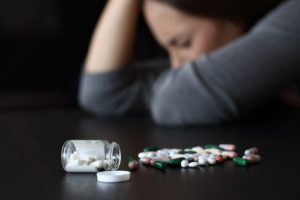Quitting a substance “cold turkey” or choosing to detox on your own can expose you to distressing and uncomfortable withdrawal symptoms. What’s more, within hours or days, those symptoms can lead to relapse and even overdose.
In her first-person account for Tonic, Tracey Duncan wrote that quitting opioids cold turkey made her want to die.
She described her opioid withdrawal experience thusly:
“It feels like the worst flu you ever had, the sickest you’ve ever been, times suicidal thoughts and complete and total confidence that you are never, ever, ever going to feel better. It feels like the day your wife left and your kitten died and there were no more rainbows anywhere and never will be again.”
Attempting to detox on your own from opioids, alcohol, or benzodiazepines can indeed be deadly. The dangerous effects of withdrawal are not limited to those substances, either. If you have taken a particular drug like cocaine, methamphetamine, or ecstasy in large doses and/or over a long period and decide to detox, you can subject yourself to more pronounced withdrawal symptoms.
The safest, most effective means of kicking a drug or alcohol habit is to undergo a medically supervised detox, where a physician can oversee your process as the addictive substance is removed from your system.
Dangers of Substance Abuse Withdrawal
Withdrawal symptoms are the physical and psychological disturbances that happen after a substance leaves the body. When these reactions occur, a substance dependency has been established, according to the National Institute on Drug Abuse (NIDA). Why? Because someone has become accustomed to having a drug or alcohol present in his system. Once he stops using, his body can go haywire.
Drugs and alcohol can produce withdrawal symptoms that range from uncomfortable to debilitating. The substances that generate symptoms with the deadliest consequences are alcohol, opioids, and benzodiazepines.
Alcohol Withdrawal
When abused over a long period or on a single occasion, alcohol can inflict deleterious withdrawal symptoms. However, the common effects associated with its use can be unpleasant as well.
These include:
- Insomnia
- Shakiness
- Irritability
- Anxiety
- Depression
- Nausea and vomiting
- Sweating and chills
- Headache
- Feeling exhausted
- Difficulty concentrating
- Increased heart rate
- Pale skin
While those symptoms can be managed and alleviated through medication and minor intervention from treatment specialists, the more severe effects require significant attention and medical supervision. The severe symptoms of withdrawal often experienced by people with a history of heavy drinking are as follows:
- Dilated pupils
- Rapid heartbeat
- High blood pressure
- Fever
- Accelerated breathing
- Tremors in the hands
- Seizures
Why Quitting Alcohol Cold Turkey is Dangerous

Alcohol withdrawal can be unpredictable. Symptoms can occur out of the blue and become worse over time. Attempting to detox on your own can be dangerous, especially in the event of an emergency.
When someone abruptly stops drinking, it impacts the balance of gamma-Aminobutyric acid (GABA) and glutamate, the two brain chemicals that govern calmness and excitability, respectively. Why? Because alcohol increases the GABA and lessens the glutamate. The more you drink, the more difficult it is for the brain to produce more GABA and less glutamate. Thus, the brain overcompensates for this imbalance by producing less of the calming chemical (GABA) and more of the excitability component (glutamate).
Even when you stop drinking the brain continues to produce the excitability chemical. Thus, the withdrawal symptoms that result are due to the overproduction of glutamate, and the perilous, effects of excitability like tremors, high blood pressure, and life-threatening seizures can ensue.
The risk of death is present with the most severe form of alcohol withdrawal, which is called delirium tremens or DTs. DTs often occur for people who have been heavy drinkers for more than 10 years. The symptoms of DTs include:
- Sudden severe confusion
- Body tremors
- Deep sleep lasting for a day or longer
- Excitement
- Fear
- Hallucinations
- Sudden mood changes
- Irritability
- Bursts of energy
- Restlessness
- Sleepiness and fatigue
- Sensitivity to light, sound, or touch
- Heavy sweating
- Irregular heartbeat
- Rapid heart rate
- Seizures
Any combination of these symptoms is considered a medical emergency where treatment must begin as soon as possible. If someone is experiencing these symptoms on their own, without the aid of medical supervision, the risk of death greatly increases. These symptoms are why it’s dangerous to quit alcohol on your own.
What it’s Like to Stop Alcohol Cold Turkey
We often hear that a cold turkey alcohol detox is dangerous and can potentially kill you, but many people might wonder – what is it like? If you’re at a point where you must quit drinking alcohol, it means the drug is profoundly affecting your life. Many people assume that drinking isn’t as dangerous as illicit drugs because it’s legal. Unfortunately, that couldn’t be any further from the truth.
One question people ask – is whether it is safe to stop drinking cold turkey. The answer is no, which is why it’s such a dangerous drug, despite its legality. If you’ve reached the point where it’s time to stop and want to get your life back on track, it’s important to know what it’s like to stop alcohol cold turkey – there are potential flu-like symptoms of alcohol withdrawal that make the process incredibly difficult.
Half of those with an alcohol use disorder (AUD) will experience withdrawal symptoms when they stop drinking, and alcohol withdrawal cold chills are something you’ll encounter when stopping cold turkey. The symptoms can range from mild to severe, but the intensity depends on the following:
- Your overall health
- How long you’ve been drinking alcohol
- How much alcohol is consumed when you drink
- Co-occurring medical issues or psychological problems
The time it takes to detox from alcohol varies from person to person. However, those with a full-blown alcohol addiction will experience symptoms in three phases.
Phase One of Alcohol Withdrawal
The initial phase of alcohol withdrawal starts around the six-hour mark after your last drink. Symptoms may mimic an intense hangover and include the following:
- Agitation
- Nausea and vomiting
- Tremors
- Headache
- Sweating
- Sleeplessness
Phase Two of Alcohol Withdrawal
Like benzodiazepines, alcohol withdrawal can cause similar symptoms. Many people wonder – can benzodiazepine withdrawal kill you? The answer is yes, and so can alcohol withdrawal. The second phase of alcohol detox is the most dangerous if you stop drinking cold turkey. It typically starts a day after your last drink and can last 48 hours or longer, depending on the severity of your alcohol use disorder. The second phase of alcohol withdrawal is when you’re at the greatest risk of severe withdrawal symptoms. You’ll experience the following in phase two:
- Convulsions
- Severe anxiety
- Whole body tremors
- High blood pressure
- Sweating
- Vomiting
- High body temperature
- Insomnia
- Nausea
- Hallucinations
- Delirium tremens (DTs)
Phase Three of Alcohol Withdrawal
The final phase of alcohol withdrawal is likely to consist of psychological symptoms. If you can get past the physical symptoms safely, you’ll have to endure depression and other uncomfortable symptoms later. Many people make it through the physical symptoms, only to relapse when they reach this point, which is why alcohol addiction treatment is critical. You can get past the physical symptoms with detox, but if you don’t treat the underlying reasons you become addicted, you’ll likely fall victim to relapse once you leave detox. To avoid throwing away the hard work it took to reach that point, seek help.
During the final phase of alcohol withdrawal, you might go through post-acute withdrawal syndrome (PAWS). These can last for weeks, months, or sometimes up to a year after you stop drinking as your body and brain resume normal functioning. By seeking professional help, you can learn how to cope with these often severe symptoms without giving in to temptations to drink. The third phase consists of the following:
- Depression
- Anxiety
- Low motivation
- Mood swings
- Feelings of dissatisfaction
- Never feeling at ease with yourself
- Intense urges to drink when you’re triggered
For these reasons and more, you shouldn’t quit drinking cold turkey.
Opioid Withdrawal
When a person stops using opioids, whether they are of the prescription variety like hydrocodone or the illicit kind like heroin, they will experience flu-like withdrawal symptoms, which in and of themselves are not deadly. However, they are painful and uncomfortable enough to lock someone into a cycle of abuse. Also, the effects tend to be both physical and psychological and occur in phases.
Phase One Opioid Withdrawal Symptoms
- Muscle aches
- Joint pain
- Agitation and restlessness
- Anxiety and nervousness
- Increased watering of the eyes
- Runny nose
- Excessive yawning
- Fatigue
- Insomnia
- Sweating
Phase Two Symptoms
- Diarrhea
- Nausea and vomiting
- Stomach and intestinal cramps
- Dilated pupils
- Cold shivers
- Goosebumps
Why Quitting Opioids Cold Turkey is Dangerous

Attempting to quit opioids on your own can produce disastrous consequences, up to and including death. An all-too-common story around opioid addiction is when someone attempts to quit cold turkey, but the symptoms prove to be too much so that person resumes use. Because they may not have the tolerance they once had, they may end up taking too much, which can result in overdose and death.
Expert Sherry Benton explains about the dangers of opioid relapse, “People tend to go back to the level of the drug they were taking when they used, but they no longer have the tolerance, and now it’s enough to kill you.”
The leading cause of death from opioids is respiratory depression. This occurs when someone simply stops breathing.
The other life-threatening symptom of opioid abuse is dehydration, which can lead to hypernatremia or a high sodium level in the blood. This occurs when someone experiences severe fluid loss due to vomiting, diarrhea, sweating, and/or not drinking sufficient water.
Signs of Severe Hypernatremia
- Brain dysfunction, including extreme confusion
- Muscle twitching
- Seizures
- Coma
When you have the benefit of a physician supervising your detox process, they can administer the medication and treatments necessary to alleviate those withdrawal symptoms. They can also administer medication-assisted treatment drugs such as naltrexone or Suboxone to help wean you off the original opioid that was used.
Benzodiazepine Withdrawal
Diazepam (Valium), clonazepam (Klonopin), and alprazolam (Xanax) are used to treat anxiety, panic attacks, and stress reactions. Typically, benzos are only prescribed as short-term medications. A user can become dependent on them within two to four weeks of regular consumption. These drugs can quickly produce tolerance, dependence, and even addiction in a user.
Symptoms of Benzodiazepine Withdrawal
- Faster breathing
- Accelerated heartbeat
- Physical tremors
- Muscle spasms
- Weight loss from appetite changes
- Sweating
- Abnormal body sensations
- Joint pain
Benzos can produce withdrawal symptoms that they were initially prescribed to treat, like anxiety. Other effects that result from benzodiazepine withdrawal include:
- Sleep deprivation or trouble sleeping
- Sensitivity to lights or sound
- General anxiety or mood swings
- Panic attacks
- Visual disturbances
- Depression
Why Quitting Benzos Cold Turkey is Dangerous
It is dangerous to attempt to detox from benzos on your own, especially if you take large doses of the drug. Taking benzodiazepines in such a manner predisposes you to a seizure disorder. The most common type of seizures from benzos are grand mal seizures, which are life-threatening.
According to the Mayo Clinic, a grand mal seizure can make a sufferer lose consciousness and experience violent muscle contractions.
You can experience intense perceptual changes and psychotic effects from benzos, which can result in hospitalization. What’s more, suddenly quitting benzos can also lead to the development of post-acute withdrawal syndrome (PAWS), where you experience mood issues, intense cravings, discomfort, and anxiety attacks that can last for months or even years after quitting.
A medically supervised benzodiazepine detox process where a physician can treat those symptoms of withdrawal can curb the threat of grand mal seizures and PAWS.
Benefits of Professional Treatment

Drug or alcohol withdrawal can fool the body into believing it cannot function normally without either substance. When you abruptly cease use to detox, it will kick up these disturbances to get you to reuse. The most effective solution to break up this cycle is professional addiction treatment.
A professional recovery program will ensure that the substance of abuse is removed from the body, and the mind and soul are treated. This process begins medical detoxification, which is administered through acute treatment. At this stage, medical staff will provide 24-hour supervision and care while treating distressing withdrawal symptoms that arise. During this process, the body and brain’s natural chemistries are restored.
For opioid, alcohol, and benzodiazepine addictions there is clinical stabilization, which provides comprehensive therapy and counseling that gets to the underlying causes of addiction. This process is also useful for people who have addictions to cocaine, methamphetamine, or barbiturates. Clinical stabilization is typically 30 to 90 days, but NIDA recommends at least a 90-day stay to maximize the effectiveness of treatment.
If additional counseling and therapy are needed, there is outpatient treatment, which provides these services on a part-time basis.
After treatment is completed, a caseworker can help you get connected to a recovery community, which can provide support and be a critical hedge against relapse.
Get Help Today
You do not have to risk your life by facing these dangerous withdrawal symptoms on your own. We can help you locate a treatment program that can free you from addiction and its tragic consequences.
Call 855-956-4940 anytime, day or evening, for a free consultation with one of our knowledgeable addiction recovery specialists. They can help you find the right treatment option. You can also contact us online for more information.
Alcohol, Benzos, and Opiates-Withdrawal That Might Kill You. (n.d.). Retrieved from: https://www.psychologytoday.com/us/blog/all-about-addiction/201001/alcohol-benzos-and-opiates-withdrawal-might-kill-you
Delphi Behavioral Health Group. (2018, December 19). Cold-Turkey Detox from Opiates: Dangers and What to Expect. Retrieved from: https://delphihealthgroup.com/cold-turkey-detox/opiates/
Delphi Behavioral Health Group. (2019, January 08). Can Alcohol Withdrawal Cause Death? How? Retrieved from: https://delphihealthgroup.com/alcohol/withdrawal-death/
Delphi Behavioral Health Group. (2019, March 02). How to Ease the Symptoms of Benzo Withdrawal. Retrieved from: https://delphihealthgroup.com/benzodiazepines/ease-withdrawal/
Quitting Opioids Cold Turkey Made Me Want to Die. (2017, November 28). Retrieved from: https://tonic.vice.com/en_us/article/xwan5n/quitting-opioids-cold-turkey-made-me-want-to-die
Grand mal seizure. (2018, December 07). Retrieved from: https://www.mayoclinic.org/diseases-conditions/grand-mal-seizure/symptoms-causes/syc-20363458
What Are the Risks of Quitting Substance Use Cold Turkey? Retrieved from: https://www.verywellmind.com/what-are-the-risks-of-quitting-cold-turkey-21813
National Institute on Drug Abuse. (n.d.). What classes of prescription drugs are commonly misused? Retrieved from: https://www.drugabuse.gov/publications/misuse-prescription-drugs/what-classes-prescription-drugs-are-commonly-misused


